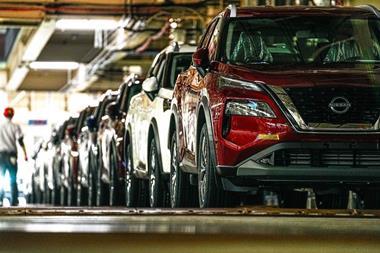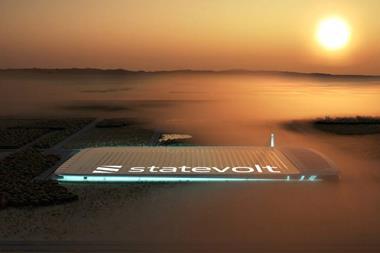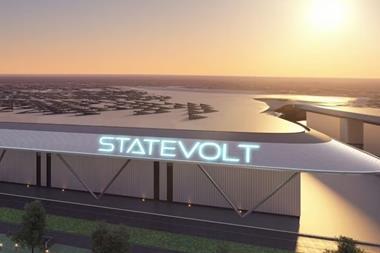GM Holden chairman and managing director Mike Devereux, head of GM’s Australian operations, talks to Glen Brooks about future vehicle platforms, the rescue of a key supplier, and overseeing new export programmes
AMS: You’ve been chairman and managing director of GM Holden since March 2010, leading the company through a period of growth for almost three years now. What’s ahead for Holden over next three years?
MD: Certainly a shift to global platforms. The notion of us just doing things individually in Australia for this market is really not something that is allowed in the global auto business, so we’re moving to two global vehicle architectures. Building things in this country is supremely important and connected to us being an Australian brand.
AMS: Which two platforms will that be?
MD: They will be successor platforms to our current two. So that’s Delta, which we have for our locally made Cruze, and Zeta 2, which is the rear-wheel drive platform which we launch later in 2013.
AMS: Has there been a lot of re-engineering to update Zeta to the forthcoming Zeta 2 specification? MD: For the VF Commodore, which we launch this year, there’s quite a few updates, both visually and more importantly under the skin. These will make the car second to none at its price point.
AMS: What has the engineering priority been? To get weight out of the car and make the new model more fuel-efficient?
MD: All of the above. Of the funding for this vehicle, a small chunk came from the Green Car Innovation Fund: the Australian government co-invested to the tune of about AU$39 million (US$40.5 million) in our project for the VF Commodore. That was mostly to do with light-weighting of components sets – aluminium and some other materials – that we’ll be using much more than we have in the past. The customer will see a significant update to the way the car drives, and also inside the vehicle the technologies will be another step ahead. This is going to be a world-class car, not often replicated in the mainstream marketplace: rear-wheel drive cars are usually luxury models.
AMS: What sort of percentage of this new model series will be for export markets?
MD: It’s not a huge percentage. We sent about 6,000 cars to the Middle East in 2012; over 3,000 police cars to the United States; then add to that exports of the new Chevrolet SS to the US later this year. So if we build 80-90,000 units, with New Zealand, we’re talking about 10,000-15,000 units from that total. We’re no longer in the days when the Australian dollar was worth just 50 US cents. In the life of our current Commodore, the value of the currency has doubled, since 2005. Doubled! A 100% increase in the cost of making the car.
AMS: It must have been tough getting GM to agree to investment for a new family of rear-wheel drive vehicles, mostly just for the Aussie market.
MD: If you think about the volumes of Commodore today, with the sedan and the wagon, plus the Ute [pick-up] and the Caprice [long-wheelbase luxury sedan], you’re talking about 40,000 units. That’s still a pretty good amount of production and the model series is still one of the top five cars in this country. A lot of people love their Commodores but we’re not going to sell 85,000 or 90,000 units like we did a few years ago when we didn’t have all these imports. Now we have a very strong currency and almost zero tariffs, with 60 brands beating their brains out for just over a million units. Plus, this is one of the most fragmented markets in the world and competition is fierce. You’ve got all the Chinese, all the Europeans, you’ve got the Indians here – you don’t see that in the North American market. But even with all those factors, we have a good business case for our large, rear-wheel drive vehicles programme. I believe the new Commodore will be a very successful car.
AMS: If Australia isn’t a cheap place to do business, how is it that Holden also has one of GM’s key global design centres?
MD:Melbourne is a very global city, designers are very creative people and so it’s not surprising that so many of them want to live here [Holden’s portside headquarters is just 5km from central Melbourne]. From a culture and climate standpoint, this is a great city and it attracts talent. Our design team is also regarded by Ed Welburn [GM vice-president of global design] as a very talented team. Five years ago I’d say the design and engineering team here would have worked almost exclusively on Holden projects – about 85% would have been stuff for Australia. Now it’s about 80-85% for other places. We’ll soon be doing more engineering work for Asia, specifically China, and in the design world, for whatever reason, we really understand the Buick brand. We do a lot of work for Buick, and also for GMC – SUVs specifically – and a lot of advanced work and concepts for the Buick brand. We also have a very strong mentoring organisation for our nascent design centre in India, and for our partners up in Korea and in China.
AMS: How closely do you work with state and federal governments to secure added investment for Holden?

As chairman and managing director of GM Holden Ltd, Mike Devereux is responsible for the organisation’s business operations in Australia and New Zealand. He took up his current role in March 2010, prior to which he was president and managing director of GM Middle East Operations.
Devereux’s career with General Motors began in 1984 in his native Canada. As a co-op engineering student at the St. Catharines Engine and Foundry Complex, he worked in a variety of engineering and manufacturing roles. Full-time employment with GM came fi ve years later while working in product development and sales for AC Delco and GM Parts. After leaving Parts and Service, Devereux then served as launch manager for the 2000 Cadillac DeVille, working on the vehicle line team that developed the car.
After a brief stint as director of e-Sales at GM’s e-Business unit, Devereux returned to Aftersales in 2001 as director of service merchandising for GM SPO. Two years later he became director of business management in GM’s Global Sales, Service and Marketing (GSSM) organisation. Then in 2005, Devereux took over as executive director of GM’s digital marketing and CRM efforts.
MD: It’s a fact of life everywhere on the planet that you have to work closely with government – if you’re investing billions of dollars, you have to have policy that is coherent, concise and consistent over time. If it’s not, it makes it very difficult to build cars competitively.
AMS: How expensive do you consider Australia to be in terms of total manufacturing costs?
MD: I believe Australia is the highest cost place in the world to build cars. Some people say Canada is more expensive but, at least within GM, we have one of the highest per-unit manufacturing costs – that’s a GM list that I don’t want to be number one on.
AMS: Do you think the average Australian auto industry worker is aware of that situation?
MD: I think we’ve been very transparent with the workforce about the challenges of making things in this country. We had a political action campaign in 2011 where many workers wrote to their local members of parliament, just to tell them the facts about the global auto business – about the large investments that have been made in the UK, or in the US where Mercedes-Benz got almost half a billion dollars to build the Vance, Alabama plant, or Hyundai getting a quarter billion dollars from the state of Georgia. There are lots of good examples where we all did a good job of explaining to politicians here that this is an industry worth fighting for because of the big multiplier effect that the auto industry has everywhere.
AMS: High fixed costs were said to be the reason why one of your suppliers got into difficulties a few months back, resulting in an extended production stoppage. Was Autodom* an isolated case or the first of more potential weak links to come for your supply chain?
MD: I think we had seen the Autodom situation coming for a long time. We have good relationships with our suppliers and an understanding of their financial positions. It might have seemed like a crisis management situation, but we had been working with the company for quite some time to try to get them to a different place with their cost structure and their future investment strategy. There came a point where we had to step in, as did Ford, because we were relying on Autodom supplying us with a number of critical components. Now, I believe there is a future for the company; for a world-class, restructured Autodom.
AMS: How can suppliers in Australia become more competitive?
MD: I can give you some examples of companies that have diversified away from just making things for the local auto industry. In some cases, that means making components for the global industry. Diver Consolidated makes heat shields for the transmission tunnel of the Chevrolet Camaro. They ship around 90,000 of them to Canada each year – they don’t make them for here – they got the business because they were a supplier to Zeta [the same basic GM architecture as used by the Holden Commodore] in this country. So they’re supplying to the Oshawa Assembly Plant in Ontario, out of Australia.
 Another example; there’s a little company that makes acoustic shields for the wheel-wells of cars. It supplies Commodore here, but also supplies BMW in Germany and a few automakers in China – not because it’s the cheapest but because it has the best, high-tech product that’s also fully recyclable. So I think there is a path for the supply base in this country.
Another example; there’s a little company that makes acoustic shields for the wheel-wells of cars. It supplies Commodore here, but also supplies BMW in Germany and a few automakers in China – not because it’s the cheapest but because it has the best, high-tech product that’s also fully recyclable. So I think there is a path for the supply base in this country.
AMS:When your new rear-wheel drive range is launched later in 2013, will all models and body styles be replaced? MD: We’ll do variants of all the cars when we do the VF next May.
AMS: One of your main existing export programmes is a Chevrolet-badged version of the Holden Caprice. Will that continue?
MD: We send that car to Brazil, to South Africa, to markets in the Middle East. So that’s left-hand drive and right-hand drive vehicles. We also manufacture the Chevrolet Caprice PPV – a police pursuit vehicle – for export to the US.
AMS:What is the current capacity utilisation of your Elizabeth plant [Holden’s only vehicle production facility, located in the state of South Australia]?
MD: I’m not going to evade your question but the capacity utilisation is not what we want it to be; we don’t run three shifts there. We run two shifts in many parts of the plant – in paint, and body and other places – and in general assembly we run one shift. We used to run two shifts in general assembly but we brought the afternoon shift onto the day shift and made more cars on that one shift. Elizabeth is a local plant for local consumption. Australia is a relatively small market but we have a very flexible plant. We build over 45 different variants of vehicles: Cruze sedans and hatches; Commodore wagons and sedans; Utes; long wheelbase (Caprice and PPV). They all come down the same line, left-hand and right-hand drive. If we didn’t have the talented workforce that we have, we couldn’t do all that.
AMS: How does Elizabeth rank against other GM facilities that manufacture or assemble the Cruze?
 MD: In terms of using people’s time, the way we build our Cruze makes us the most productive operation of any plant in the world that builds that model. We are employing our labour as efficiently as we can. It is very expensive labour, no question, but the only way around that is supreme flexibility and that’s what we focus on.
MD: In terms of using people’s time, the way we build our Cruze makes us the most productive operation of any plant in the world that builds that model. We are employing our labour as efficiently as we can. It is very expensive labour, no question, but the only way around that is supreme flexibility and that’s what we focus on.
AMS: There have been media reports which claim Elizabeth will move towards full manufacturing of the next Cruze.
MD: We’d be stupid not to build a small car; it’s the single largest segment of the Australian market. Our scope in building Delta 2 [vehicles] will be similar to what we have today. We get some parts from Korea but that will change to another CKD source. We haven’t defined where that source will be.
AMS:Apart from Cruze and the forthcoming new VF rearwheel drive cars, will there be other vehicles for the Elizabeth plant?
MD: The current Cruze has been a really big success. It’s a top-five selling car in the country and we’ve been building it (CKD) for a year and a half. We’ll likely build another one of those and we have to pick another architecture to go into the plant.
AMS: A rear-wheel drive successor to the Commodore series then, later this decade?
MD: Something other than the Cruze. So that could be an SUV, it could be a car, it could be a minivan. At this point, I can’t tell you. What I will tell you is that we have to have two vehicles that will be top-ten sellers. The margin for error is razor thin and making the right decision is vital because of the fragmentation of this marketplace.


































